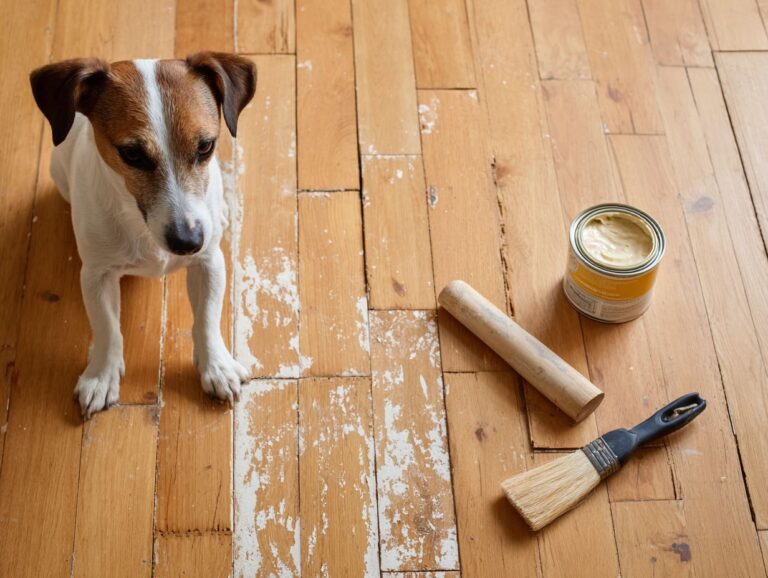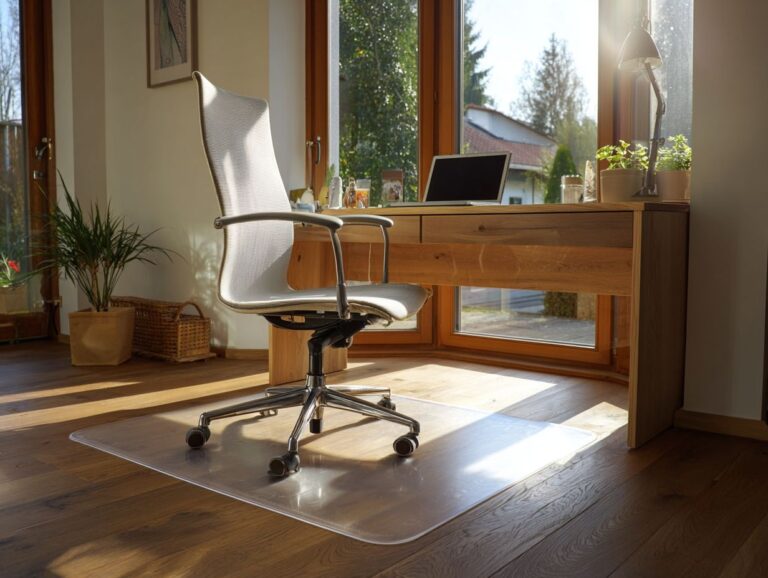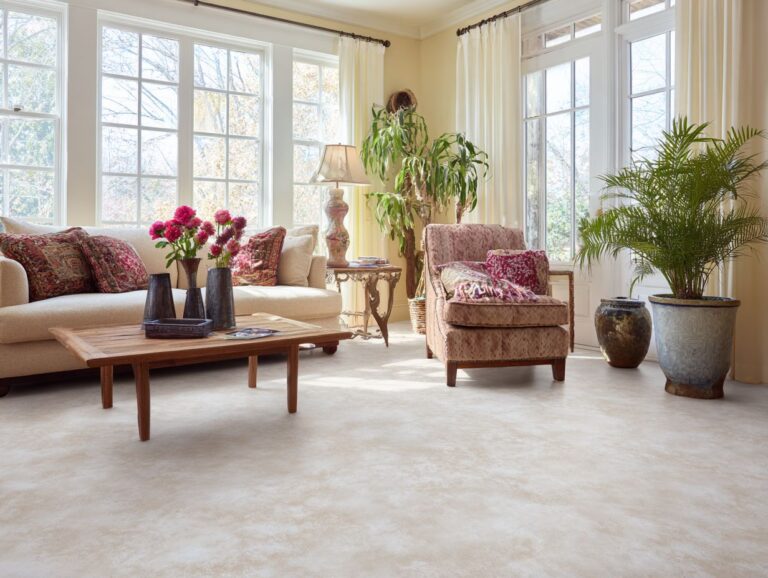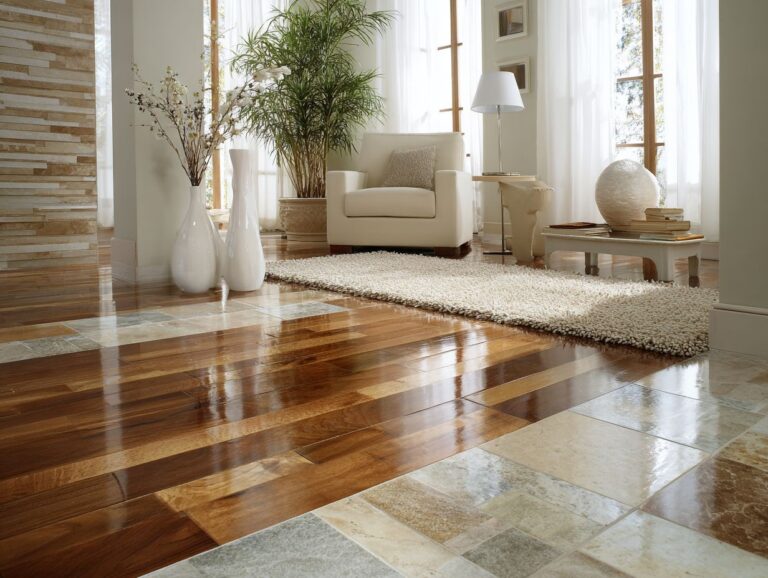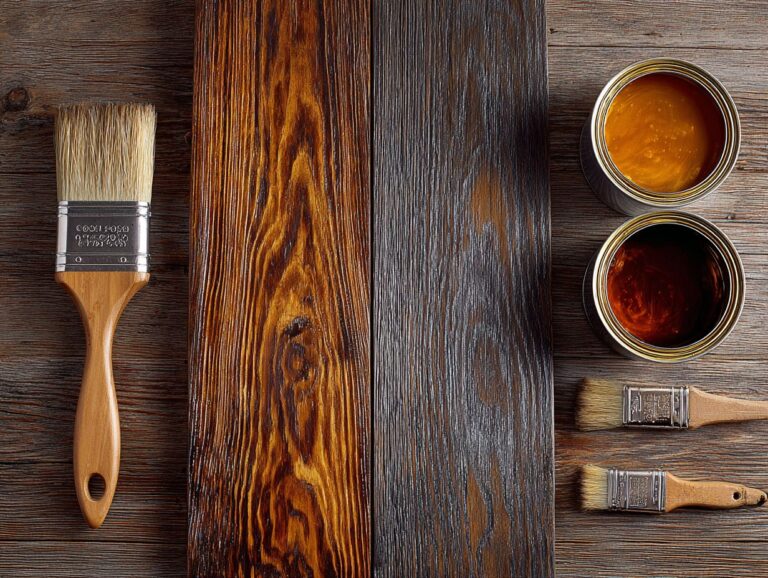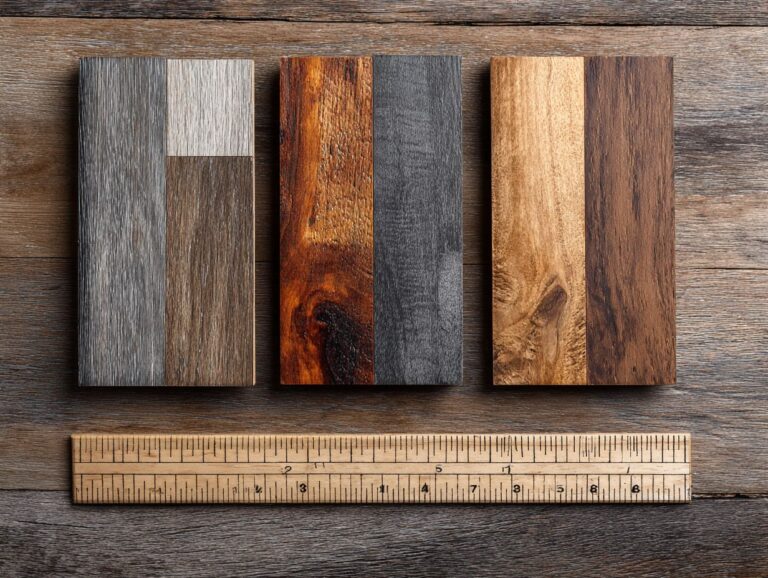Great Room Flooring Ideas – Large Space Considerations
Choosing the right flooring can greatly improve your great room. In a house with an open design, choosing the best wood flooring-whether it’s traditional hardwood or trendy luxury vinyl plank-can improve how your space looks and works. This article looks at different flooring options for large spaces, helping you choose the best one for your home. Learn how to combine aesthetics and functionality in your main room today!
Key Takeaways:
Contents
- Types of Flooring Materials
- Flooring Trends 2024 Analysis
- Design Considerations
- Practical Considerations
- Environmental Considerations
- Styling Your Great Room
- Frequently Asked Questions
- 1. What are some flooring options for a large great room space?
- 2. How can I make my great room flooring durable?
- 3. Are there any flooring options specifically designed for large spaces?
- 4. What are the benefits of using carpet in a large great room?
- 5. Can I mix and match flooring in my great room?
- 6. How do I choose the right flooring for my great room?
Importance of Flooring in Large Spaces
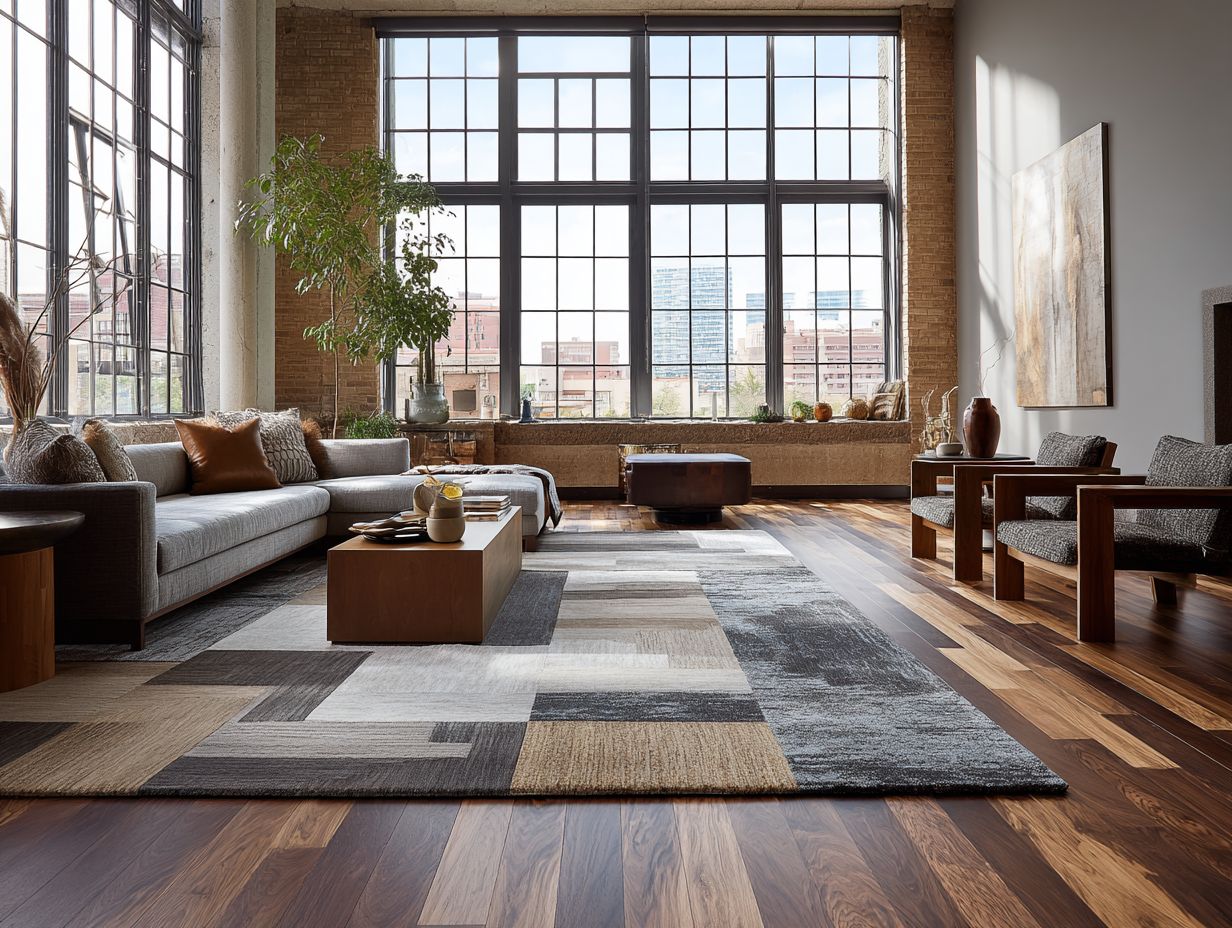
Flooring acts as a foundation for design continuity, influencing the visual perception and flow of large spaces.
Picking the right flooring can make a space look better and connect different areas in an open layout.
For example, large living spaces often benefit from hardwood floors, which provide warmth and elegance, creating a cozy atmosphere.
In contrast, tiles can offer a sleek, modern look, particularly when transitioning from the kitchen to the dining area.
Luxury vinyl planks are strong and resist water, which suits busy areas well.
By maintaining a consistent color palette and texture, you can unify various zones, enhancing the overall aesthetic of your space. For more insights on how to achieve this, explore our in-depth guide on open floor plan flooring and creating visual flow.
Factors to Consider for Great Room Flooring
When selecting flooring for a great room, consider durability, moisture levels, and the comfort it provides underfoot.
Hardwood is a classic choice, offering warmth and elegance but can be scratched or damaged by moisture.
Laminate mimics the appearance of high-end materials but is cheaper and resists spills effectively, making it great for homes with children.
If you’re prioritizing comfort and warmth, consider luxury vinyl planks, which mimic wood but are waterproof and boast softer underfoot.
No matter which option you pick, make sure it matches your room’s lighting and furniture. Always request samples to check how the flooring looks in your space before deciding.
Types of Flooring Materials
Different types of flooring materials are accessible, each providing distinct advantages and looks suitable for large living areas. For those exploring unique and durable flooring options, consider how concrete flooring offers polished, stained, and stamped possibilities that can enhance the aesthetic and functionality of a space.
Flooring Trends 2024 Analysis
Flooring Trends 2024 Analysis
Explore the latest trends in laminate manufacturing, where innovative approaches like high-pressure and direct-pressure techniques are gaining prominence. As mentioned in our analysis of High-Pressure vs Direct-Pressure Laminate Manufacturing, these methods offer distinct benefits and challenges that are shaping the industry.
Key Trends in Flooring: Materials & Preferences
Key Trends in Flooring: Design Trends
The Flooring Trends 2024 Analysis provides useful information on new patterns in the flooring sector, highlighting the growing significance of material choices and design advancements. As consumers become more conscious of sustainability and aesthetics, the flooring market is undergoing significant changes.
Key Trends in Flooring highlight the growing preference for certain materials and design styles. The data reveals a 30% growth in the use of sustainable materials, reflecting a shift towards eco-friendly flooring options. This trend indicates a rising consumer demand for products that minimize environmental impact, such as bamboo and recycled materials.
- Luxury Vinyl Tile (LVT) dominates the market with a 50% usage rate, favored for its durability, affordability, and variety of design options. LVT’s water resistance and ease of installation make it a popular choice for both residential and commercial spaces.
- Warm and Natural Tones are adopted by 40% of consumers, emphasizing a desire for comforting and earthy aesthetics in interior design. This preference aligns with broader trends towards creating cozy, inviting living spaces.
The Design Trends section shows varied consumer preferences. Checkerboard patterns25% popularity, evoke classic elegance and nostalgia, while colored and graphic floors, at 15% appeal to those who want strong, creative designs in their homes.
Additionally, large format tiles are chosen by 35% of consumers, valued for their modern look and ability to make spaces appear larger and more cohesive. This trend reflects a desire for sleek, minimalistic designs.
In summary, the Flooring Trends 2024 Analysis shows a market driven by the need for eco-friendly practices and a desire for varied, custom designs. The data suggests that manufacturers and retailers should focus on increasing their selection of eco-friendly materials and a wide range of design choices to meet changing consumer preferences.
Hardwood Flooring
Hardwood flooring, particularly engineered hardwood, provides both timeless beauty and modern resilience for high-traffic areas.
With installation costs ranging from $5 to $10 per square foot, consider using a professional for the best results.
Engineered hardwood is more resistant to moisture than solid wood, making it suitable for basements or kitchens.
To maintain its aesthetic appeal, regularly sweep or vacuum to remove dirt, and use a damp mop with a hardwood floor cleaner. Avoid excessive water exposure, as this can warp the planks.
Regular care helps your flooring stay shiny and strong for a long time.
Laminate Flooring
Laminate flooring is a budget-friendly option that looks like wood but costs less.
Typically priced between $1 and $5 per square foot, laminate is a budget-friendly choice for homeowners.
It’s easy to install, perfect for those who like to do it themselves; simply snap the planks together without using glue or nails. Laminate flooring is strong and lasts a long time, which makes it perfect for homes with pets because it doesn’t easily get scratched or stained.
Pick a texture that looks like real wood grain for a genuine look, improving your area without spending too much.
Tile Flooring
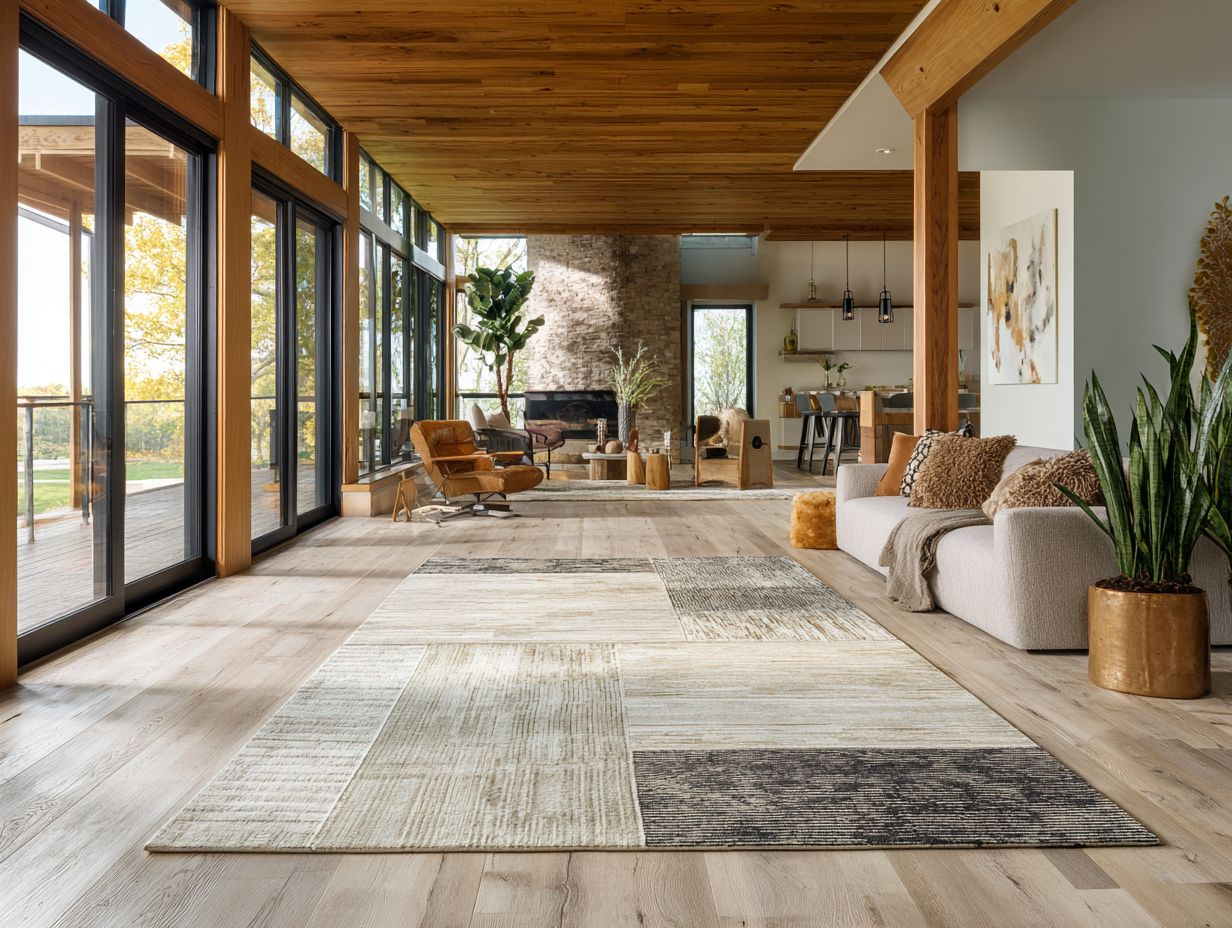
Tile flooring, particularly porcelain and natural stone, offers excellent durability and style for modern great rooms.
Its resistance to moisture makes it an excellent choice for high-humidity areas like kitchens and bathrooms.
Installation costs typically range from $3 to $15 per square foot, depending on the material and labor. For example, a high-quality porcelain tile may cost around $6 per square foot, while a luxurious natural stone option could be $12 or more.
The tiles are easy to clean and maintain, helping to maintain a pristine environment. With proper insulation, tile floors can keep your space warm, providing a flexible flooring option.
Carpet Options
Carpet flooring adds warmth and comfort to great rooms, perfect for creating cozy, inviting spaces for family gatherings.
You can choose from many types of carpets, including wool and synthetic fibers.
Wool is renowned for its insulation benefits, naturally regulating temperature and providing durability, though it tends to cost between $4 to $5 per square foot.
Synthetic choices, such as nylon or polyester, typically cost between $2 and $3 per square foot and resist stains, which makes them suitable for households with kids or pets.
To make your carpet last longer, vacuum it regularly and have it cleaned by professionals every 12-18 months. This will help keep it in great shape.
Vinyl Flooring
Luxury vinyl plank (LVP) is popular because it looks good and can resist water, which makes it useful in many places.
This type of flooring usually costs from $2 to $7 for each square foot, offering a budget-friendly option for most homeowners.
Putting it in place is simple, usually needing only tools like a utility knife and a vinyl plank cutter, so people who enjoy DIY projects can do it by themselves.
LVP’s ability to resist moisture makes it ideal for kitchens, bathrooms, and basements. Its strong build allows it to handle lots of people walking on it, which makes it a good option for homes or business areas.
Design Considerations
The type of flooring you choose can significantly affect the feel and appearance of a large room.
Color Schemes
Choosing the right color for your flooring can dramatically affect the room’s brightness and perceived space.
Light-colored flooring options, like white oak, maple, or soft beige, reflect natural light and create a welcoming warmth.
A light grey laminate can brighten sunlight, helping a small room feel more open. A light-hued carpet can soften the aesthetic while providing comfort underfoot.
When selecting flooring, consider samples in natural light to see how they interact with your space. Pair these colors with lighter wall paints for a cohesive and spacious feel, using shades like soft pastels or creamy whites.
Patterns and Textures
Using patterns and textures in your flooring can make your great room more visually appealing.
For instance, consider using geometric patterned tiles in the dining area to create a focal point, while pairing them with a solid, textured carpet in the living space to add warmth.
A herringbone pattern in hardwood can improve the overall look. Tools like Canva can help visualize these combinations before implementation.
A lot of homeowners prefer this mix because the textures give the room a softer feel and the patterns highlight different sections, which makes the rooms seem more connected and energetic.
Transitioning Between Spaces
Seamless changes between flooring styles are important for keeping a consistent look in large spaces.
To achieve seamless transitions, consider using transition strips that accommodate height differences, such as T-molding for floors of equal height or reducer strips for transitioning down to carpet.
Choose transition strips in colors that match both types of flooring for a consistent look. For example, if you have oak hardwood and gray tile, a strip in medium oak or gray stain can bring the appearance together.
Make sure the floor patterns match up to give a more unified look; small changes can make a big difference in how it looks.
Practical Considerations
When choosing flooring for large rooms, consider how long it will last, how easy it is to clean, and how much it will cost to install.
Durability and Maintenance
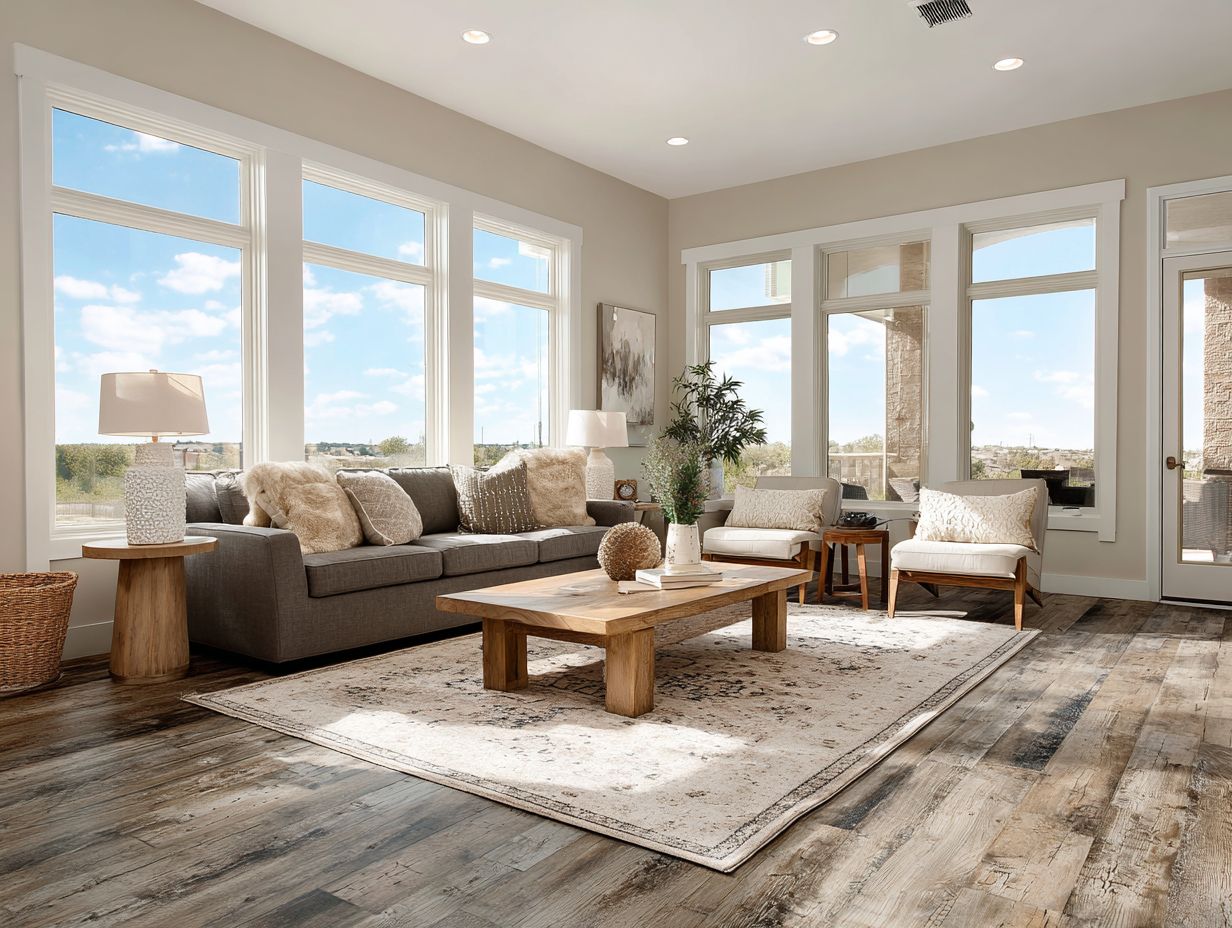
The durability of flooring materials is paramount, especially in high-traffic areas like great rooms.
To take care of different types of flooring properly, follow these tips for three common materials: hardwood, tile, and carpet.
-
Hardwood floors require regular sweeping and monthly polishing to guard against scratches.
-
For tile, a weekly mopping with suitable cleaners will keep grime at bay, while addressing grout lines bi-annually preserves its aesthetic.
-
Carpets should be vacuumed weekly and professionally cleaned every 12 to 18 months.
Following a maintenance plan keeps your living areas looking good and lasting longer.
Cost and Budgeting
Knowing the costs of different flooring materials helps homeowners plan their great room renovations within their budget.
Common flooring options include hardwood, which ranges from $8 to $15 per square foot installed, providing a timeless look.
Laminate is a budget-friendly choice, with installation costs between $2 and $6. It works well in busy areas.
Vinyl plank flooring, priced at $3 to $7, also provides water resistance and durability.
To manage your budget well, think about using financing choices like credit cards with no interest or loans for home repairs. Always request multiple estimates to find the best deal while ensuring quality installation.
Installation Methods
Choosing the right installation method can impact both the cost and quality of your flooring project.
It’s important to consider both do-it-yourself and hiring a professional for installation. DIY can save you money but requires skills, tools, and time-invest in a good flooring installer for a seamless finish.
Instead, hiring a contractor brings skill; check for good reviews and pictures of previous work. To find the right professional, request quotes from multiple contractors, check their references, and verify their credentials.
This method balances expenses with quality work, ensuring your flooring enhances your home for years.
Environmental Considerations
When choosing flooring for your great room, think about how eco-friendly it is and how it affects the air inside your home. Additionally, it’s important to consider the visual flow of your space. Creating a seamless transition between areas can significantly enhance the overall aesthetic of your interior design.
Eco-Friendly Flooring Options
Eco-friendly flooring options like bamboo and reclaimed wood lessen harm to the environment and give your great room a distinct look.
Sustainable materials like cork and linoleum also offer great alternatives.
Cork, priced around $3-$7 per square foot, provides excellent insulation and is sourced from renewable bark. Linoleum, costing approximately $4-$8 per square foot, is made from natural materials like linseed oil and can last over 40 years with minimal maintenance.
To source these materials, visit local eco-friendly flooring stores or online retailers specializing in sustainable options. Regular cleaning and occasional refinishing will keep them looking great and help you maintain an eco-friendly lifestyle.
Indoor Air Quality and Flooring
Selecting the right flooring can greatly impact indoor air quality, so it’s important to pick materials with low levels of volatile organic compounds and those that cause few allergic reactions.
Opt for flooring materials like cork, bamboo, or natural fibers such as sisal and jute.
Cork, for example, is sustainable and has natural antimicrobial qualities. It contributes to improved air quality by regulating humidity. Bamboo is another excellent choice, as it grows quickly and is inherently resistant to mold and mildew.
For areas needing carpeting, consider natural fiber rugs made from wool or cotton, which are less likely to emit harmful chemicals. These materials can substantially reduce allergens and create a healthier indoor environment.
Styling Your Great Room
Decorating your main living area involves coordinating the floor, furniture, and decorations for a cohesive appearance.
Complementing Furniture and Decor
Choosing flooring that matches your furniture and decor can improve the overall look of your great room.
To choose the right flooring color and texture, consider the style of your furniture.
For modern furniture with clean lines, light woods or sleek tiles in neutral tones work well, creating a fresh backdrop. Rustic or farmhouse styles benefit from distressed hardwoods in warmer shades, adding warmth. For a bohemian style, choose colorful tiles or patterned laminate that match diverse furniture.
Tools like color swatches from local hardware stores can help visualize how different flooring interacts with your furniture, ensuring you achieve the desired harmony in your space.
Area Rugs and Their Impact
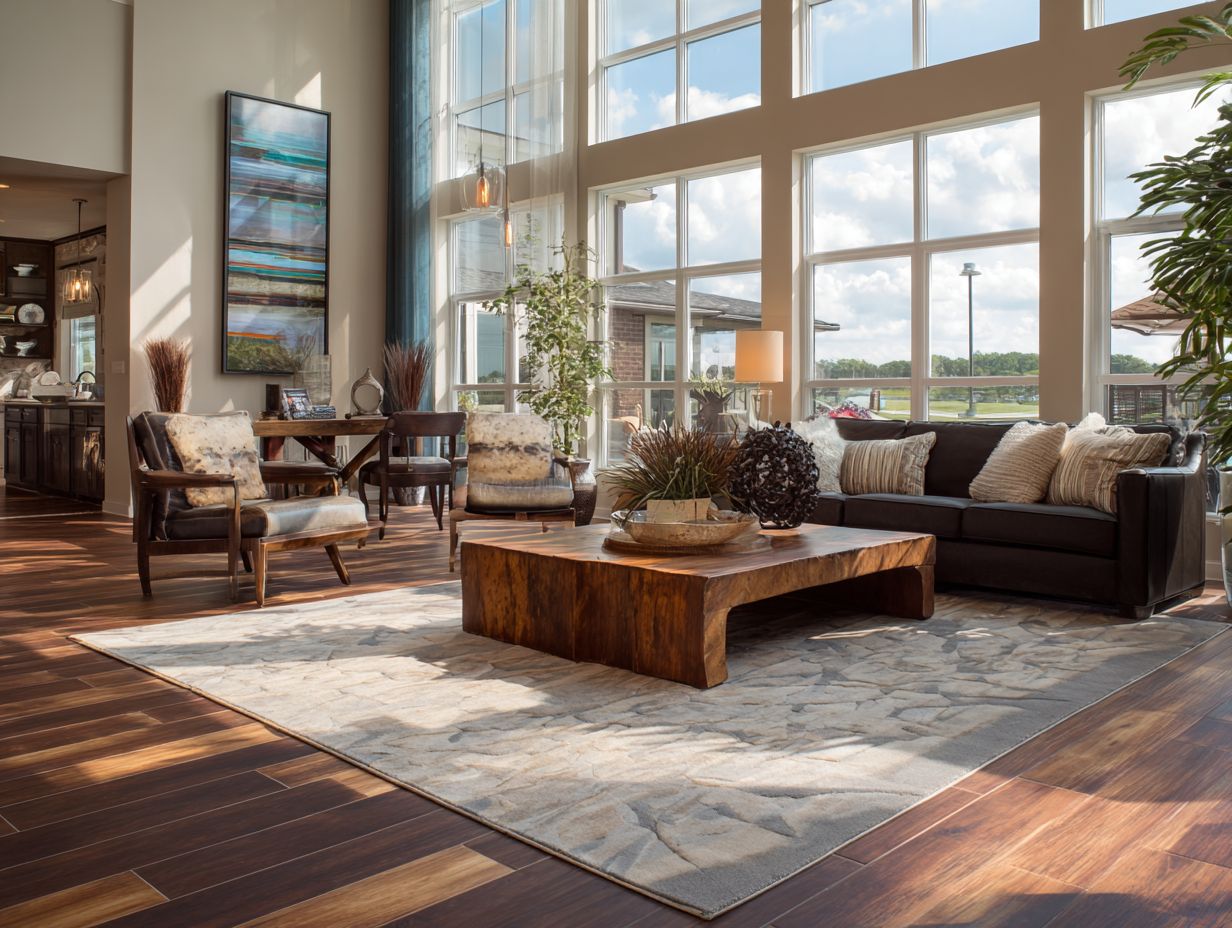
Area rugs can make a room feel comfortable and help divide different sections in a large open space, making them important for decoration.
When selecting an area rug, consider its size relative to your furniture; ideally, all furniture should fit on or at least partially on the rug.
Opt for natural materials like wool or cotton for their durability and comfort. Coordinate the rug’s colors and patterns with your flooring; for instance, a solid-colored rug can provide contrast against patterned tile or hardwood.
Make sure the rug’s texture fits your room-sleek rugs can suit modern spaces, while fluffy styles can add to a warm, classic look.
Final Thoughts on Great Room Flooring
With many flooring choices, it’s important to find a good mix of appearance, comfort, and usefulness.
To make an informed choice, consider the following popular options:
- Hardwood offers timeless elegance and durability;
- Laminate provides affordability while mimicking wood;
- Vinyl, available in various designs, is waterproof and easy to maintain.
Visit local flooring stores to see samples, ensuring you test textures and colors in your own lighting.
Consult with flooring experts who can assess your specific needs-whether it’s foot traffic, moisture levels, or personal style-helping you choose the perfect fit for your space.
Frequently Asked Questions
1. What are some flooring options for a large great room space?
Some flooring options for a large great room space include hardwood, laminate, tile, and carpet.
2. How can I make my great room flooring durable?
You can make your great room flooring durable by choosing materials that are known for their durability, such as hardwood or tile. You can also consider adding a protective layer or sealant to your flooring.
3. Are there any flooring options specifically designed for large spaces?
Yes, there are flooring options designed specifically for large spaces, such as wide plank hardwood or oversized tile. These options can help create a more cohesive and visually appealing look in your great room.
4. What are the benefits of using carpet in a large great room?
Carpet can provide warmth and comfort in a large great room, and also help with noise reduction. It can also offer a softer surface for children to play on.
5. Can I mix and match flooring in my great room?
Yes, you can mix and match flooring in your great room to create a unique and visually interesting space. Just make sure the materials and colors complement each other and flow well together.
6. How do I choose the right flooring for my great room?
When choosing flooring for your great room, consider the overall style and design of the room, the amount of foot traffic it will receive, and your budget. It’s also important to choose a flooring material that is both functional and visually appealing for your space.
